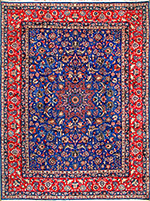Textiles Studies

Textile Research Works
Date of this Version
1994
Document Type
Article
Citation
Middle East Studies Association Bulletin, July 1994, Vol. 28, No. 1, pp. 28-30
Abstract
Review of: The Mediation of Ornament, by OLEG GRABAR & Problems of Style: Foundations for a History of Ornament, by ALOIS RIEGL.
TWO MAJOR WORKS addressing the nature of art, published in the same year but written a century apart, are each based, in part, upon analyses of Islamic monuments. Both derive from series of lectures on the history of ornament, and each offers a perspective explicitly countering the author's own intellectual milieu in the study of art focused on Western tradition.
Problems of Style is an impressive translation of Stilfragen, a broadly-based and wide-ranging inquiry by Alois Rieg] that, in spite of its difficult but precise vocabulary, has become a standard reference in the study of style since its first appearance in 1893. Although Riegl's focus is more specifically on art of the ancient Near East and the Mediterranean world of classical antiquity, his view that the development of vegetal ornament from Egypt, the Ancient Near East and the Hellenistic world culminates in the Islamic arabesque has served as the point of departure for numerous studies such as Ernst Kiihnel's seminal Die Arabeske (Wiesbaden, 1949), translated by Richard Ettinghausen as The Arabesque: Meaning and Transformation of an Ornament (Graz, 1977). The question of meaning in ornament continues to attract scholarly interest (e.g., James Trilling's "'Meaning' and Meanings in Ornament: In Search of Universals," Raritan 12: 52-69, 1993).
The Mediation of Ornament proceeds along a path of inquiry charted by some of Grabar's earlier works that articulate important issues arising from the thoughtful consideration of individual major monuments or groups of objects (The Great Mosque of Isfahan [New York, 1990]; The Illustrations of the Maqamat [Chicago, 1984]; The Alhambra [London, 1978]; The Fonnation of Islamic An [New Haven, 1973]; the Introduction to Sasanian Silver [Ann Arbor, 1967]). But The Mediation of Ornament diverges from his previous analyses: it does not seek to elucidate particular monuments, although it dramatically illustrates Grabar's wellknown penchant for raising questions without necessarily providing answers. Here, Grabar is not focused on the phenomenon of Islamic art; instead, he uses Islamic art as a means of access to the phenomenology of art. This stance is not, I think, intentionally rhetorical, nor is it a record of idle musings; it is an honest statement of one scholar's personal intellectual journey. Grabar's open-ended approach may hint at what could be the supreme function of art-that is, to effect an awareness of the unknown or the unknowable that manifests itself as a feeling of uncertainty or inadequacy, rife with ambiguity.
Included in
Art and Materials Conservation Commons, Art Practice Commons, Fiber, Textile, and Weaving Arts Commons, Indigenous Studies Commons, Museum Studies Commons

